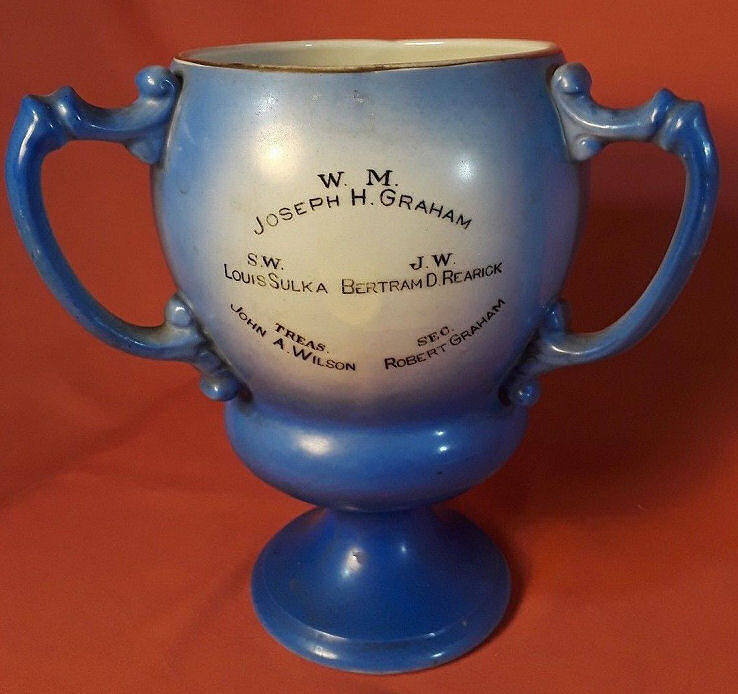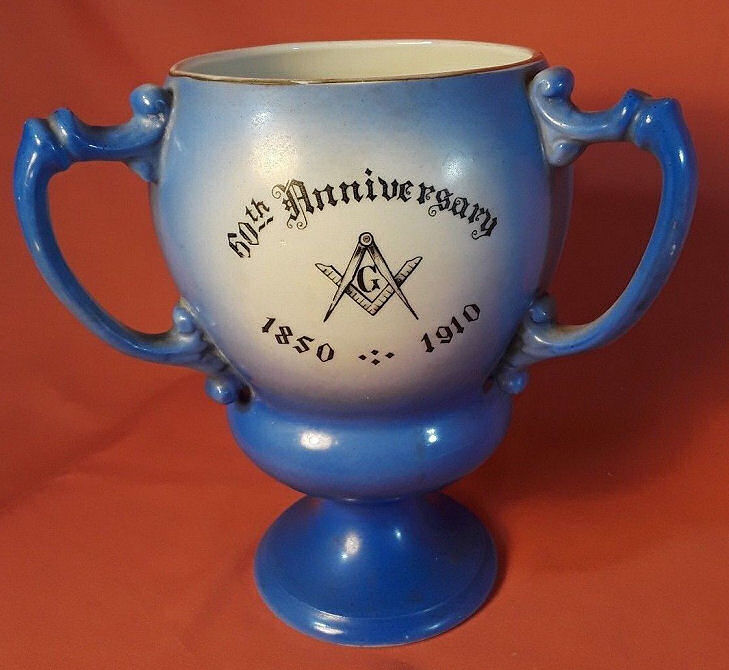Shekinah Lodge No. 246
Three Handle Loving Cup



Shekinah Lodge No. 246 was organized in 1850 and
still meets in Norman Hall at the Grand Lodge of Pennsylvania Temple, 1 North
Broad Street in Philadelphia. This cup commemorates their 60th Anniversary
from 1850-1910.
The word shekinah does not appear in the Bible, but the
concept clearly does. The Jewish rabbis coined this extra-biblical expression, a
form of a Hebrew word that literally means “he caused to dwell,” signifying that
it was a divine visitation of the presence or dwelling of the Lord God on this
earth. The Shekinah was first evident when the Israelites set out from Succoth
in their escape from Egypt. There the Lord appeared in a cloudy pillar in the
day and a fiery pillar by night: “After leaving Succoth they camped at Etham on
the edge of the desert. By day the LORD went ahead of them in a pillar of cloud
to guide them on their way and by night in a pillar of fire to give them light,
so that they could travel by day or night. Neither the pillar of cloud by day
nor the pillar of fire by night left its place in front of the people” (Exodus
13:20–22).
God spoke to Moses out of the pillar of cloud in
Exodus 33, assuring him that His Presence would be with the Israelites (v.
9). Verse 11 says God spoke to Moses “face to face” out of the cloud, but when
Moses asked to see God’s glory, God told Him, “You cannot see My face; for no
man shall see Me, and live” (v. 20). So, apparently, the visible manifestation
of God’s glory was somewhat muted. When Moses asked to see God’s glory, God hid
Moses in the cleft of a rock, covered him with His hand, and passed by. Then He
removed His hand, and Moses saw only His back. This would seem to indicate that
God’s glory is too awesome and powerful to be seen completely by man.
The visible manifestation of God’s presence was seen not only by the Israelites
but also by the Egyptians: “During the last watch of the night the LORD looked
down from the pillar of fire and cloud at the Egyptian army and threw it into
confusion. He made the wheels of their chariots come off so that they had
difficulty driving. And the Egyptians said, ‘Let's get away from the Israelites!
The LORD is fighting for them against Egypt’” (Exodus
14:24-25). Just the presence of God’s Shekinah glory was enough to convince
His enemies that He was not someone to be resisted.
In the New Testament, Jesus Christ is the dwelling place of God’s glory.
Colossians 2:9 tells us that “in Christ all the fullness of the Deity lives
in bodily form,” causing Jesus to exclaim to Philip, “Anyone who has seen me has
seen the Father” (John
14:9). In Christ, we see the visible manifestation of God Himself in the
second person of the Trinity. Although His glory was also veiled, Jesus is
nonetheless the presence of God on earth. Just as the divine Presence dwelled in
a relatively plain tent called the “tabernacle” before the Temple in Jerusalem
was built, so did the Presence dwell in the relatively plain man who was Jesus.
“He had no beauty or majesty to attract us to him, nothing in his appearance
that we should desire him” (Isaiah
53:2). But when we get to heaven, we will see both the Son and the Father in
all their glory, and the Shekinah will no longer be veiled (1
John 3:2).

